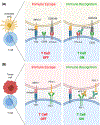Photothermal therapies to improve immune checkpoint blockade for cancer
- PMID: 33426992
- PMCID: PMC7808273
- DOI: 10.1080/02656736.2020.1797190
Photothermal therapies to improve immune checkpoint blockade for cancer
Abstract
Immune checkpoint blockade (ICB) comprising monoclonal antibodies (mAbs) against immune 'checkpoints', such as CTLA-4 and the PD1/PDL1 axis have dramatically improved clinical outcomes for patients with cancer. However, ICB by itself has failed to provide benefit in a wide range of solid tumors, where recurrence still occurs with high incidence. These poor response rates may be due to the therapeutic shortcomings of ICB; namely, a lack of cancer-specific cytotoxicity and ability to debulk tumors. To overcome these limitations, effective ICB therapy may require the combination with other complementary therapeutic platforms. Here, we propose that photothermal therapy (PTT) is an ideal therapeutic modality for combination with ICB because it can generate both tumor-specific cytotoxicity and immunogenicity. PTT elicits these specific effects because it is a localized thermal ablation technique that utilizes light-responsive nanoparticles activated by a wavelength-matched laser. While ICB immunotherapy alone improves cancer immunogenicity but does not generate robust antitumor cytotoxicity, nanoparticle-based PTT elicits targeted and controlled cytotoxicity but sub-optimal long-term immunogenicity. Thus, the two platforms offer complementary and potentially synergistic antitumor effects, which will be detailed in this review. We highlight three classes of nanoparticles used as agents of PTT (i.e., metallic inorganic nanoparticles, carbon-based nanoparticles and organic dyes), and illustrate the potential for nanoparticle-based PTT to potentiate the effects of ICB in preclinical models. Through this discussion, we aim to present PTT combined with ICB as a potent synergistic combination treatment for diverse cancer types currently refractory to ICB as well as PTT monotherapies.
Keywords: Photothermal therapy; cancer; immune checkpoint blockade; immunotherapy; nanoparticle; thermal ablation.
Conflict of interest statement
Declaration of Interest
The authors report no conflicts of interest
Figures


Similar articles
-
Allomelanin-based biomimetic nanotherapeutics for orthotopic glioblastoma targeted photothermal immunotherapy.Acta Biomater. 2023 Aug;166:552-566. doi: 10.1016/j.actbio.2023.05.037. Epub 2023 May 24. Acta Biomater. 2023. PMID: 37236575
-
Multifunctional nanoparticles precisely reprogram the tumor microenvironment and potentiate antitumor immunotherapy after near-infrared-II light-mediated photothermal therapy.Acta Biomater. 2023 Sep 1;167:551-563. doi: 10.1016/j.actbio.2023.05.051. Epub 2023 Jun 10. Acta Biomater. 2023. PMID: 37302731
-
Combination of phototherapy with immune checkpoint blockade: Theory and practice in cancer.Front Immunol. 2022 Sep 2;13:955920. doi: 10.3389/fimmu.2022.955920. eCollection 2022. Front Immunol. 2022. PMID: 36119019 Free PMC article. Review.
-
Photothermally sensitive gold nanocage augments the antitumor efficiency of immune checkpoint blockade in immune "cold" tumors.Front Immunol. 2023 Oct 24;14:1279221. doi: 10.3389/fimmu.2023.1279221. eCollection 2023. Front Immunol. 2023. PMID: 37942337 Free PMC article.
-
Advancing cancer immunotherapy through siRNA-based gene silencing for immune checkpoint blockade.Adv Drug Deliv Rev. 2024 Jun;209:115306. doi: 10.1016/j.addr.2024.115306. Epub 2024 Apr 16. Adv Drug Deliv Rev. 2024. PMID: 38626859 Review.
Cited by
-
The Thermal Dose of Photothermal Therapy Generates Differential Immunogenicity in Human Neuroblastoma Cells.Cancers (Basel). 2022 Mar 11;14(6):1447. doi: 10.3390/cancers14061447. Cancers (Basel). 2022. PMID: 35326601 Free PMC article.
-
Proteotoxic Stress as an Exploitable Vulnerability in Cells with Hyperactive AKT.Int J Mol Sci. 2021 Oct 21;22(21):11376. doi: 10.3390/ijms222111376. Int J Mol Sci. 2021. PMID: 34768807 Free PMC article.
-
Neuroblastoma-A Review of Combination Immunotherapy.Int J Mol Sci. 2024 Jul 15;25(14):7730. doi: 10.3390/ijms25147730. Int J Mol Sci. 2024. PMID: 39062971 Free PMC article. Review.
-
Combination of a novel heat shock protein 90-targeted photodynamic therapy with PD-1/PD-L1 blockade induces potent systemic antitumor efficacy and abscopal effect against breast cancers.J Immunother Cancer. 2022 Sep;10(9):e004793. doi: 10.1136/jitc-2022-004793. J Immunother Cancer. 2022. PMID: 36171008 Free PMC article.
-
Immunotherapy for Triple-Negative Breast Cancer.Pharmaceutics. 2021 Nov 25;13(12):2003. doi: 10.3390/pharmaceutics13122003. Pharmaceutics. 2021. PMID: 34959285 Free PMC article. Review.
References
-
- Martins GA, Tadokoro CE, Silva RB, Silva JS, Rizzo LV. CTLA-4 Blockage Increases Resistance to Infection with the Intracellular Protozoan Trypanosoma cruzi. The Journal of Immunology. 2004;172(8):4893. - PubMed
-
- Ariyan C, Salvalaggio P, Fecteau S, Deng S, Rogozinski L, Mandelbrot D, et al. Cutting Edge: Transplantation Tolerance through Enhanced CTLA-4 Expression. The Journal of Immunology. 2003;171(11):5673. - PubMed
Publication types
MeSH terms
Substances
Grants and funding
LinkOut - more resources
Full Text Sources
Medical
Research Materials
